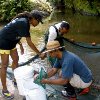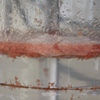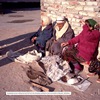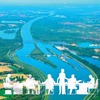World Water Week 2013 - All about water by ERC projects
The European Research Council (ERC) that supports world-class researchers in Europe, working in any field of research, has invested a total budget of around €95 million to support over 50 innovative projects dealing with water issues. Many of these projects tackle key topics in water research, involving disciplines as diverse as environment, life sciences, engineering, material sciences or social sciences.

The European Research Council (ERC) that supports world-class researchers in Europe, working in any field of research, has invested a total budget of around €95 million to support over 50 innovative projects dealing with water issues. Many of these projects tackle key topics in water research, involving disciplines as diverse as environment, life sciences, engineering, material sciences or social sciences. The projects presented in this brochure are investigating the changes in rivers floods, new biotech tools for waste water treatment, the application of the EU water legislation, the resilience of population and ecological communities to climate change, or the design of computational methods for predicting the performance of buildings against water hazards.
World Water Week 2013, Stockholm, Sweden, 1-6 September 2013
World Water Week is organised by Stockholm International Water Institute (SIWI) and takes place each year in Stockholm. The World Water Week has been the annual focal point for the globe’s water issues since 1991. The ERC will be present at the 2013 conference exhibition.
Understanding river floods and their causes
 Major floods around the world have raised questions about the frequency and magnitude of such phenomena. Although changes in climate and land use are known to play a critical role in river floods, how they actually translate into considerable variations in intensity remains unknown. Prof. Günter Blöschl addresses this issue with a comprehensive approach, which includes the analysis of 200 years of flood data from selected catchments (i.e. areas where waters from rain falls and melting snow or ice converge) along three European axes (UK-Italy, Scandinavia-Romania and Spain-Hungary). With all these data, Prof. Blöschl aims to build a flood-change model that could predict how variations in one parameter (e.g. change in weather, storms, soil moisture or land management) could affect floods levels. The model will be tested for the different catchments and also be compared with results from data-based methods. His research will make it possible to clarify the effects of land use and climate on floods, a vital step towards predicting how floods will change in the future.
Major floods around the world have raised questions about the frequency and magnitude of such phenomena. Although changes in climate and land use are known to play a critical role in river floods, how they actually translate into considerable variations in intensity remains unknown. Prof. Günter Blöschl addresses this issue with a comprehensive approach, which includes the analysis of 200 years of flood data from selected catchments (i.e. areas where waters from rain falls and melting snow or ice converge) along three European axes (UK-Italy, Scandinavia-Romania and Spain-Hungary). With all these data, Prof. Blöschl aims to build a flood-change model that could predict how variations in one parameter (e.g. change in weather, storms, soil moisture or land management) could affect floods levels. The model will be tested for the different catchments and also be compared with results from data-based methods. His research will make it possible to clarify the effects of land use and climate on floods, a vital step towards predicting how floods will change in the future.
Principal Investigator: Prof. Günter Blöschl
Host institution: Vienna University of Technology, Austria
Project: Deciphering River Flood Change (FLOODCHANGE)
ERC call: Advanced grant 2011
ERC funding: €2.2 million for five years
Researcher’s webpage
Portrait photo©TU Wien – Photo: Flood in Tyrol, Austria©ASI / Land Tirol / B. H. Landeck
Protecting aquatic biodiversity in a rapidly changing world
 In every ecological community, some species are abundant while others - usually the majority - are rare. This distribution of abundance remains constant over time, but the individual species within this distribution are not static: some rare species may become common while others may become locally extinct. These on-going, natural changes are likely to be accelerated in response to climate change or disturbances such as the arrival of invasive species. Prof. Anne Magurran studies freshwaters, marine and terrestrial ecosystems to predict and quantify how this distribution changes and at what pace, both as a consequence of natural evolution and under the influence of human activity. She also looks at the capacity of the aquatic communities to resist- and to recover from- these changes. Models developed in the project will provide practical solutions for the conservation of biodiversity in two very different areas: the county Fife (Scotland, UK), where the management history is well known; and two reserves of the Amazonian rainforest (Brazil), where more than 500 species of fishes have already been recorded.
In every ecological community, some species are abundant while others - usually the majority - are rare. This distribution of abundance remains constant over time, but the individual species within this distribution are not static: some rare species may become common while others may become locally extinct. These on-going, natural changes are likely to be accelerated in response to climate change or disturbances such as the arrival of invasive species. Prof. Anne Magurran studies freshwaters, marine and terrestrial ecosystems to predict and quantify how this distribution changes and at what pace, both as a consequence of natural evolution and under the influence of human activity. She also looks at the capacity of the aquatic communities to resist- and to recover from- these changes. Models developed in the project will provide practical solutions for the conservation of biodiversity in two very different areas: the county Fife (Scotland, UK), where the management history is well known; and two reserves of the Amazonian rainforest (Brazil), where more than 500 species of fishes have already been recorded.
Principal Investigator: Prof. Anne E. Magurran
Host institution: University of St. Andrews, UK
Project: Biological diversity in an inconstant world: Temporal turnover in modified Ecosystems (BioTIME)
ERC call: Advanced grant 2009
ERC funding: €1.8 million for five years
Researcher’s webpage
Portrait photo©A Magurran -- Photo: Sampling fish in rivers in Trinidad’s Northern Range.
This work is part of a 5-year study of temporal and spatial turnover in biodiversity in tropical freshwaters©A Magurran
Biotechnology at the service of waste water treatment
 As water resources are under severe pressure, smart sustainable systems are needed to clean waste waters for instance. The ANAMMOX project focuses on the ecology of freshwater systems and in particular on the microbial processes at the interface between the sediment and the water. Researchers have enriched the bacteria responsible for the “anammox” reaction (i.e. the removal of ammonium in environments lacking oxygen like e.g. wastewater) in the sediments of Dutch drainage ditches and studied their complete genome. They investigated how lab-grown anammox bacteria use nitrite to convert ammonium and release nitrogen that is harmless for the environment. The team is now trying to understand which enzyme enables the production of hydrazine (a highly toxic chemical compound) in the process, which may improve our understanding of the biogeochemical nitrogen cycle. It could also pave the way for developing cheaper technology with lower CO2 emissions to clean waste water plants and remove organic micro pollutants. Based on these preliminary results, the team received an additional “Proof of Concept” grant to bring the technology closer to the market.
As water resources are under severe pressure, smart sustainable systems are needed to clean waste waters for instance. The ANAMMOX project focuses on the ecology of freshwater systems and in particular on the microbial processes at the interface between the sediment and the water. Researchers have enriched the bacteria responsible for the “anammox” reaction (i.e. the removal of ammonium in environments lacking oxygen like e.g. wastewater) in the sediments of Dutch drainage ditches and studied their complete genome. They investigated how lab-grown anammox bacteria use nitrite to convert ammonium and release nitrogen that is harmless for the environment. The team is now trying to understand which enzyme enables the production of hydrazine (a highly toxic chemical compound) in the process, which may improve our understanding of the biogeochemical nitrogen cycle. It could also pave the way for developing cheaper technology with lower CO2 emissions to clean waste water plants and remove organic micro pollutants. Based on these preliminary results, the team received an additional “Proof of Concept” grant to bring the technology closer to the market.
Principal Investigator: Prof. Michael Jetten
Host institution: Radboud University Nijmegen, The Netherlands
Project: Anaerobic ammonium oxidizing bacteria: unique prokayotes with exceptional properties (ANAMMOX)
ERC call: Advanced grant 2008
ERC funding: €2.5 million for five years ERC Proof of Concept grant: ‘Low-temperature Anammox for Nitrogen Removal’ (LTANITRO) funded for up to €150.000 for one year.
Researcher’s webpage
Methane-munching bacteria that can help save the environment
Photo: Anammox bioreactor
Identifying opportunities and challenges for resilient societies and environments
 Little is known about the interactions between natural ecosystems, human behaviours and societal decisions in so-called ‘social-ecological systems’ (SESs) over time. However, it is essential to understand their influence on the sustainable use of resources, including water, and human well-being. In this relatively new research field, Dr Schlüter combines theoretical modelling with in depth studies of three water systems: rice irrigation landscapes in Bali; water management in the Amudarya river basin (Uzbekistan); and marine ecosystem-management in the Baltic Sea. For each of them, she aims to identify relevant ecological and social dynamics (for instance the development of shared norms of resource use), and the links between them that determine SES outcomes. One of her objectives is to understand how the SESs copes with- and adapts to global changes, including climate change. With her team, she sets out to develop an integrative framework and methodology to systematically study these questions across disciplines and case studies; and to help policy-makers define sustainable water management strategies for the environments studied.
Little is known about the interactions between natural ecosystems, human behaviours and societal decisions in so-called ‘social-ecological systems’ (SESs) over time. However, it is essential to understand their influence on the sustainable use of resources, including water, and human well-being. In this relatively new research field, Dr Schlüter combines theoretical modelling with in depth studies of three water systems: rice irrigation landscapes in Bali; water management in the Amudarya river basin (Uzbekistan); and marine ecosystem-management in the Baltic Sea. For each of them, she aims to identify relevant ecological and social dynamics (for instance the development of shared norms of resource use), and the links between them that determine SES outcomes. One of her objectives is to understand how the SESs copes with- and adapts to global changes, including climate change. With her team, she sets out to develop an integrative framework and methodology to systematically study these questions across disciplines and case studies; and to help policy-makers define sustainable water management strategies for the environments studied.
Principal Investigator: Dr Maja Schlüter
Host institution: Stockholm University, Stockholm Resilience Centre, Sweden
Project: The nature of social-ecological linkages and their implication for the resilience of human-environment systems (SES-LINK)
ERC call: Starting grant 2011
ERC funding: €1.28 million for five years
Researcher’s webpage
Interview of researcher (December 2012) ‘Policy-relevant principles for resilient ecosystem services’
Portrait©M Schlüter – Photo: RKiacrea kfiaellpdak women selling fowl and fish from the Amudarya wetlands at the local market in Muynak, Uzbekistan©M Schlüter
Public participation in applying European water legislation
 How does the participation of citizens in the environmental decision-making process affect policy outcomes? Answering this challenging question is the aim of Prof. Newig. Participatory governance is largely believed to enhance environmental policy benefits, leading to better informed decisions, collective learning and a stronger consideration of ecological values. However, there is currently little evidence on the role of public participation, or whether and under which conditions it influences the decision-making process. The research team is looking mainly at water policy, a key area of environmental governance, with a focus on the creation of local ‘river basin management plans’ as mandated by the European Water Framework Directive and the Floods Directive. They will study 20 regional cases across Europe in one of the first field experiments in governance research. By combining a case survey, comparative case studies and field experimentation, this ERC project aims to assess what is most effective in local and regional environment governance. Furthermore, the researchers hope to reveal important insights into the functioning and performance of modern democracies.
How does the participation of citizens in the environmental decision-making process affect policy outcomes? Answering this challenging question is the aim of Prof. Newig. Participatory governance is largely believed to enhance environmental policy benefits, leading to better informed decisions, collective learning and a stronger consideration of ecological values. However, there is currently little evidence on the role of public participation, or whether and under which conditions it influences the decision-making process. The research team is looking mainly at water policy, a key area of environmental governance, with a focus on the creation of local ‘river basin management plans’ as mandated by the European Water Framework Directive and the Floods Directive. They will study 20 regional cases across Europe in one of the first field experiments in governance research. By combining a case survey, comparative case studies and field experimentation, this ERC project aims to assess what is most effective in local and regional environment governance. Furthermore, the researchers hope to reveal important insights into the functioning and performance of modern democracies.
Principal Investigator: Prof. Jens Newig
Host institution: Leuphana Universitat Lüneburg, Germany
Project: Evaluating the delivery of participatory environmental governance using an evidence-based research design (EDGE)
ERC call: Starting grant 2010
ERC funding: €900.000 for five years
Researcher’s webpage
Portrait©J Newig – Illustration©www.shutterstock.com
Towards safer constructions in water calamities
 Tsunamis like the one in Japan (2012) and Indonesia (2004) or recent flood in Central and Eastern Europe showed the fragility of civil constructions and infrastructures when confronted with water. Can the resistance of these constructions be improved? Dr Eugenio Oñate is working on a new generation of mathematical and numerical models that could predict the behaviour and safety of civil constructions during water hazards, such as flooding, large sea waves, tsunamis or water spills due to the collapse of dams or dykes. These models will combine the behaviour of the mix of water and suspended particles – ranging from nanoparticles to soil or rock particles - with data on how this fluid interacts with building surfaces. They will also take into account the type of soil on which the building is grounded and how it can erode with time and under water forces. Dr Oñate’s model should not only help to assess the safety of constructions in case of water hazard but also build more resistant and site-specific infrastructures, such as bridges, buildings, harbours or dams, and optimise emergency responses during a water hazard.
Tsunamis like the one in Japan (2012) and Indonesia (2004) or recent flood in Central and Eastern Europe showed the fragility of civil constructions and infrastructures when confronted with water. Can the resistance of these constructions be improved? Dr Eugenio Oñate is working on a new generation of mathematical and numerical models that could predict the behaviour and safety of civil constructions during water hazards, such as flooding, large sea waves, tsunamis or water spills due to the collapse of dams or dykes. These models will combine the behaviour of the mix of water and suspended particles – ranging from nanoparticles to soil or rock particles - with data on how this fluid interacts with building surfaces. They will also take into account the type of soil on which the building is grounded and how it can erode with time and under water forces. Dr Oñate’s model should not only help to assess the safety of constructions in case of water hazard but also build more resistant and site-specific infrastructures, such as bridges, buildings, harbours or dams, and optimise emergency responses during a water hazard.
Principal Investigator: Prof. Eugenio Oñate
Host institution: International Center for Numerical Methods in Engineering (CIMNE), Spain
Project: New Computational Methods for Predicting the Safety of Constructions to Water Hazards accounting for Fluid-Soil-Structure Interactions (SAFECON)
ERC call: Advanced grant 2010
ERC funding: €2.4 million for five years
Project webpage
Researcher’s webpage
Photo PI: Simulation of the dragging of objects and debris in a tsunami flow using the Particle Finite Element Method (PFEM) (wave pix www.shutterstock.com) www.shutterstock.com

